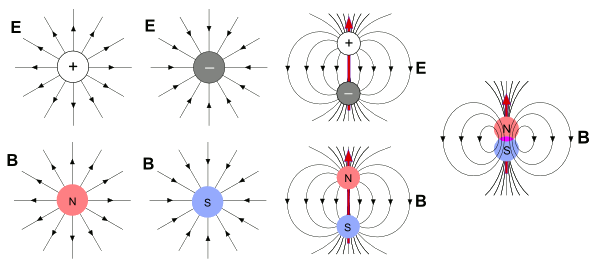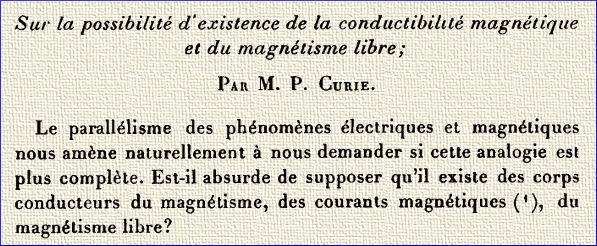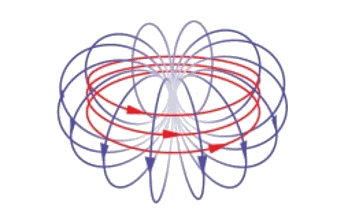Anapole Dark Matter
June 24, 2013
Today, everyone knows that
magnets have two
poles, named north and south after their similarity to Earth's
North Magnetic Pole and
South Magnetic Pole. This idea of the
dipole ("two-pole") magnet was established by the research of the
English physicist,
William Gilbert, whom I mentioned in the context of his
physical model of the
magnetic Earth in a
previous article (Magnetic Earth, June 26, 2008).
Gilbert's book,
De Magnete, Magneticisque Corporibus, et de Magno Magnete Tellure (On the Magnet and Magnetic Bodies, and on That Great Magnet the Earth), was the first
treatise on
magnetism. Until that time, magnetism was thought to be like
electricity, having two "fluids" which are attracted to each other. The north pole of a magnet attracts a south pole, just as
negatively-charged bodies attract
positively-charged bodies. A piece of magnetic material, like a bar magnet, existed in a magnetic
ground state where one fluid was stuck to another.
Gilbert discovered that breaking magnets produced smaller magnets, still with a north and south pole. This pushed the idea of magnetic fluids to the
atomic level. The principle that the properties of magnetic materials derived from their atomic properties was developed by
Wilhelm Eduard Weber, a
German physicist who was
co-inventor of the
electric telegraph with
Gauss.

Electric monopoles, and an electric dipole (top), with the analogous magnetic monopoles and dipole (bottom). The field lines of an actual magnetic dipole can be seen at the right. (Source images, monopoles and dipoles by Maschen, via Wikimedia Commons.)
An isolated north or south magnetic pole would be a
magnetic monopole. Such monopoles have not been observed, although there were many
experiments designed to detect these performed in the late
twentieth century. There's a deep reason why monopoles might exist, as discovered by
Dirac, so many physicists think they might still be found. Until that time, we still use the
equation implicit in
Maxwell's electromagnetic theory which describes
Gauss's law for magnetism; viz,
∇ ⋅ B = 0,
which states that the
divergence of the magnetic field is zero. That upside-down
delta symbol is commonly called "
del," but old-school mathematicians refer to it as a "
nabla," which is the Greek name (ναβλα) for a harp of the same shape.
This equation would need to be slightly modified if monopoles do exist,
∇ ⋅ B = μoρm,
where μ
o is the
vacuum permeability, and ρ
m would be the magnetic
charge density. The same old-timers who say "nabla" call μ
o the "permeability of free space." One old-timer who considered that magnetic monopoles could exist was
Pierre Curie. In 1894, Curie published a two-page article on the topic in the minutes of the Société Française de Physique (French Physics Society).[1]

The first paragraph from Pierre Curie's, "Sur la possibilité d'existence de la conductibilité magnétique et du magnétisme libre," (On the possible existence of magnetic conductivity and free magnetism), from the Séances de la Société Française de Physique, 1894, pp. 76-77 (1894). (Via Archive.org.)[1)]
Stranger than these field configurations is the
anapole, which exists in one form inside the
switching power supply of your
desktop computer. In that case,
electrical current in a
wire wrapped around a
toroidal core generates a magnetic field within it. There's another wire, also wrapped on this core to convert this magnetic field back to an electrical current by forming a
transformer.
Alternating currents are required for the transformer operation.

In an anapole field, the electric current (blue) flows on a toroid, so the magnetic field (red) is contained therein.
(Michael Smeltzer/Vanderbilt University image.)
Since both the electrical and magnetic field of an anapole are localized, the anapole is difficult to detect; therefore, anapole field
particles would be difficult to detect. Such a particle would be nearly invisible when its stationary, and barely detectable while in motion. An
hypothetical elementary particle called a
Majorana fermion, first proposed in 1937, may have such a structure, and these have recently been proposed as the particles of
dark matter, the invisible substance making up about 85% of the
universe.[2-5]
Robert Scherrer, a
professor at
Vanderbilt University, and
Chiu Man Ho, a
postdoctoral fellow, have analyzed this idea in a recent article in
Physics Letters B.[4] Scherrer nicely summarized the idea that dark matter is merely anapole Majorana fermions by saying,
"There are a great many different theories about the nature of dark matter. What I like about this theory is its simplicity, uniqueness and the fact that it can be tested."[4-5]
There are simple experimental tests for this theory, unlike other theories that posit exotic particles which require exotic detection schemes.[4] Detection would still be difficult, since dark matter remaining at this time in the
chronology of the universe would be moving slowly and have very little interaction with
ordinary matter.[4]
Ho and Scherrer's theory gives an anapole moment consistent with the present detection limit of the
XENON100 Dark Matter Search Experiment of 30-40
GeV.[3] I wrote about the XENON experiment in a
previous article (Whither WIMPs, November 22, 2010). The research was supported by the
US Department of Energy in grant DE-FG05-85ER40226.[4]

Ettore Majorana, for whom the Majorana fermion is named.
Majorana led a troubled life, as detailed in the book by Joao Magueijo.[6]
Anyone who's seen Skyfall will notice the resemblance to the movie's antagonist, played by Javier Bardem.
(Sepia toned for artistic effect, via Wikimedia Commons.)
![]()
References:
- Pierre Curie, Sur la possibilité d'existence de la conductibilité magnétique et du magnétisme libre (On the possible existence of magnetic conductivity and free magnetism), Sééances de la Société Française de Physique (Société Française de physique, Paris, 1894), pp. 76-77 (1894). My non-expert translation reads, "The parallelism of electric and magnetic phenomena naturally leads us to ask ourselves whether this analogy is more complete. Is it absurd to suppose that there are conductors of magnetism, the magnetic currents of free magnetism?"
- Chiu Man Ho and Robert J. Scherrer, "Anapole dark matter," Physics Letters B, vol. 722, nos. 4–5, May 24, 2013, pp. 341-346.
- Chiu Man Ho, Robert J. Scherrer, "Anapole Dark Matter," arXiv Preprint Server, April 23, 2013.
- David Salisbury, "New, simple theory may explain mysterious dark matter," Vanderbilt University Press Release, June 10, 2013.
- Rick Pantaleo, "Simple Theory May Explain Dark Matter," Voice of America, June 11, 2013.
- Joao Magueijo, "A Brilliant Darkness: The Extraordinary Life and Mysterious Disappearance of Ettore Majorana, the Troubled Genius of the Nuclear Age," Basic Books, November 24, 2009, ISBN-13: 978-0465009039, 304 pages.
Permanent Link to this article
Linked Keywords: Magnet; magnetic pole naming conventions; North Magnetic Pole; South Magnetic Pole; dipole; English; physicist; William Gilbert; physical model; Earth's magnetic field; De Magnete, Magneticisque Corporibus, et de Magno Magnete Tellure; treatise; magnetism; electricity; electric charge; negatively-charged; positively-charged; ground state; atom; atomic; Wilhelm Eduard Weber; German; co-inventor; electric telegraph; Carl Friedrich Gauss; electric charge; electric monopole; electric dipole moment; electric dipole; magnetic monopole; magnetic dipole; dipole; experiment; twentieth century; Paul Dirac; equation; Maxwell's electromagnetic theory; Gauss's law for magnetism; divergence; delta symbol; del; nabla; vacuum permeability; charge density; Pierre Curie; Archive.org; toroidal moment; anapole; switched-mode power supply; switching power supply; desktop computer; electrical current; wire; toroidal transformer; toroidal core; transformer; alternating current; toroid; Michael Smeltzer; elementary particle; hypothesis; hypothetical; Majorana fermion; dark matter; universe; Robert Scherrer; professor; Vanderbilt University; Chiu Man Ho; postdoctoral fellow; Physics Letters B; chronology of the universe; ordinary matter; XENON100 Dark Matter Search Experiment; electronvolt; GeV; United States Department of Energy; Ettore Majorana; Skyfall; Javier Bardem; Wikimedia Commons; Pierre Curie, Sur la possibilité d'existence de la conductibilité magnétique et du magnétisme libre (On the possible existence of magnetic conductivity and free magnetism), Sééances de la Société Française de Physique (Société Française de physique, Paris, 1894), pp. 76-77 (1894); Joao Magueijo, "A Brilliant Darkness: The Extraordinary Life and Mysterious Disappearance of Ettore Majorana, the Troubled Genius of the Nuclear Age," Basic Books, November 24, 2009, ISBN-13: 978-0465009039, 304 pages.